Thermostatic Traps
The operation of a thermostatic trap (see Figure 10-20) is based on the expansion or contraction of an element under the influence of heat or cold.
Thermostatic traps are of the following two types: (1) those in which the discharge valve is operated by the relative expansion of metals and (2) those in which the action of the liquid is utilized for this purpose. The latter is probably the most commonly used thermostatic trap found in modern steam heating systems. Thermostatic traps of large capacity for draining blast coils or very large radiators are called blast traps.
Modern thermostatic traps consist of thin, corrugated-metal bel- lows or discs enclosing a hollow chamber that is filled with a liquid or partially filled with a volatile liquid. When steam comes in con- tact with the expansive element, the liquid expands or becomes a gas and thereby creates a certain amount of pressure. The element expands as a result of this pressure and closes the valve against the escape of the steam.
